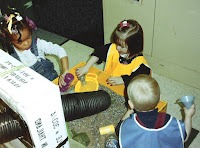Here is an apparatus I built over 20 years ago. Like many apparatus, it started out as a box that caught my eye. The box was big compared to my small sensory tables so I did not want to fit it inside either table. Instead, I decided to place it in between the two tables. That looked pretty promising.
I did not want a closed barrier between the two tables so I looked for a way to connect the two tables. I had some scrap culvert drainage pipe that I decided to embed through the box. The polyethylene pipes were sturdy so the ends did not need to be supported. Interestingly, that gave the impression that they were somewhat suspended in midair.
Besides being stiff, the drainage pipe had another unique feature: it was ribbed. As a consequence, sand would get caught in the ribs as it was poured into the pipes. That also meant there was a little delay from when a child poured sand into the pipe and when it came out the bottom.
 One thing I noticed about these old pictures is that the children seemed to enjoy working on the lowest level for their play. They knelt because the sand table is low, but kneeling also required them to use different muscle groups for balancing and doing other operations.
One thing I noticed about these old pictures is that the children seemed to enjoy working on the lowest level for their play. They knelt because the sand table is low, but kneeling also required them to use different muscle groups for balancing and doing other operations.When I first started to build apparatus for the sensory table, I took pictures to record what I built and how I built it. Because I was doing it to record what I built, I did not take a lot of pictures documenting how children made it their own. Part of the reason was that film and the developing of the film was too expensive to take gads of pictures. More importantly, though, I did not have the mindset that challenged me to do more than just record.
I am glad I was able to record. We all have to start somewhere. However, I find myself a bit empty when I try to make meaning from these old pictures. Children are competent and they are always thinking but with so little documentation with this apparatus, I cannot speculate on the meaning of their play.






No comments:
Post a Comment